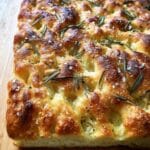Description
This Best, Easiest Focaccia Bread Recipe yields a delightfully fluffy and aromatic Italian flatbread with a crispy golden crust, perfect for sandwiches or as an accompaniment to meals. Made with simple pantry staples and an effortless overnight fermentation, this focaccia is infused with olive oil and optionally fragrant rosemary, sprinkled with flaky sea salt for an authentic texture and flavor.
Ingredients
Units
Scale
Dough Ingredients
- 4 cups (512 g) all-purpose flour or bread flour
- 2 to 3 teaspoons (10 to 15 grams) kosher salt
- 2 teaspoons (8 g) instant yeast
- 2 cups (455 g) lukewarm water (made by combining 1/2 cup boiling water with 1 1/2 cups cold water)
Additional Ingredients
- Butter for greasing pans
- 4 tablespoons olive oil, divided
- Flaky sea salt, such as Maldon, for sprinkling
- 1 to 2 teaspoons whole rosemary leaves (optional)
Instructions
- Make the dough: In a large bowl, whisk together the flour, kosher salt, and instant yeast until well combined. Add the lukewarm water to the dry ingredients. Using a rubber spatula, mix until all the liquid is absorbed and a sticky dough ball forms. Rub the surface of the dough lightly with olive oil to prevent drying. Cover the bowl securely with a damp tea towel, cloth bowl cover, or plastic wrap, and place it immediately in the refrigerator for at least 12 hours and up to 3 days to ferment slowly, which enhances flavor and texture.
- Prepare baking pans: Line two 8- or 9-inch pie plates or one 9×13-inch pan with parchment paper or grease thoroughly with butter or nonstick cooking spray to prevent sticking, especially if using glass or non-olive oil proof pans. Pour about a tablespoon of olive oil into each pan (or two tablespoons if using the larger 9×13 pan).
- Deflate and divide dough: Using two forks, gently deflate the dough by pulling it away from the sides of the bowl toward the center, rotating the bowl as you work. This releases gas and redistributes the yeast. Split the dough into two equal pieces for two pans or keep whole for the 9×13 pan. Place each dough ball into its prepared pan, rolling it in the oil to coat fully and forming a rough ball shape. Let the dough balls rest uncovered at room temperature for 3 to 4 hours to allow them to rise and come to room temperature.
- Preheat oven and prepare dough surface: Place an oven rack in the middle and preheat your oven to 425°F (218°C). If using rosemary, sprinkle the whole rosemary leaves evenly over the dough now. Drizzle a tablespoon of olive oil over each round of dough (two tablespoons if using the larger pan). Rub your hands lightly in olive oil and use your fingertips to press straight down on the dough to create deep dimples all over the surface. Gently stretch the dough if necessary to fill the pan fully. Finally, sprinkle generous flaky sea salt across the top for texture and flavor.
- Bake the focaccia: Transfer the pans to the preheated oven and bake for 25 to 30 minutes, until the focaccia turns golden brown on the bottom and has a crisp crust with a tender interior.
- Cool and serve: Remove the focaccia from the oven and transfer it to a cooling rack. Allow it to cool for at least 10 minutes before cutting to serve. If planning to make sandwiches, let it cool completely for easier slicing.
- Storage: Once completely cooled, store the focaccia in an airtight bag or container at room temperature for up to 3 days. For longer storage, freeze focaccia for up to 3 months. To revive crispness when reheating, bake at 350°F (177°C) for 15 minutes before serving.
Notes
- The long cold fermentation in the refrigerator (at least 12 hours) develops flavor and improves the bread’s texture but can be shortened if necessary; reduce fermentation times to achieve quicker results with some loss of flavor complexity.
- If using active dry yeast instead of instant yeast, proof the yeast in warm water before mixing with flour.
- Greasing pans thoroughly is critical to prevent sticking; butter is especially recommended for glass pans.
- Olive oil on the dough surface prevents drying during refrigerator fermentation, especially when using cloth covers instead of plastic wrap.
- Flaky sea salt adds a pleasant crunch and bursts of saltiness; do not substitute with fine table salt.
- Rosemary leaves are optional but provide a classic, fragrant flavor that complements the olive oil.
- For best crust texture on reheating, avoid microwaving as it softens the crust.
Nutrition
- Serving Size: 1 slice (approximately 1/12 of a loaf)
- Calories: 210
- Sugar: 0.4 g
- Sodium: 320 mg
- Fat: 8 g
- Saturated Fat: 1 g
- Unsaturated Fat: 7 g
- Trans Fat: 0 g
- Carbohydrates: 29 g
- Fiber: 1.5 g
- Protein: 5 g
- Cholesterol: 0 mg

